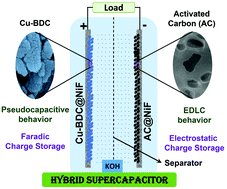One-pot synthesis of porous crystal structured nanosponge-like pristine copper metal–organic framework for hybrid supercapacitor application†
Abstract
Hybrid supercapacitors are promising energy storage devices where high-power delivery is needed in continuous supply (such as e-vehicles, cranes, industrialized machines, etc.). Metal–organic frameworks (MOFs) are leading porous materials, and their pore size and shape can be easily modified by suitable incorporation of ligands and metal centers. The way to improve a supercapacitor's energy density is to engineer pores on electrode materials properly. For large-scale applications, a facile synthesis method is needed. Therefore, a porous crystal-structured novel nanosponge-like pristine Cu-MOF is synthesized in a facile one-pot synthesis method (a coprecipitation method) which has a 2D layered crystal structure containing diffusion channels. Cu-MOF exhibits a maximum specific capacity of 892 C g−1 at 1 A g−1, showing pseudocapacitive behavior. Its specific capacity is retained at 95.3% after 10 000 charge–discharge cycles at 10 A g−1. A hybrid supercapacitor device has been fabricated with a maximum energy density of 88.2 W h kg−1 and a maximum power density of 15.7 kW kg−1. And the as-fabricated device provides a rise in specific capacity of 120% even after 10 000 charge–discharge cycles at 10 A g−1.



 Please wait while we load your content...
Please wait while we load your content...